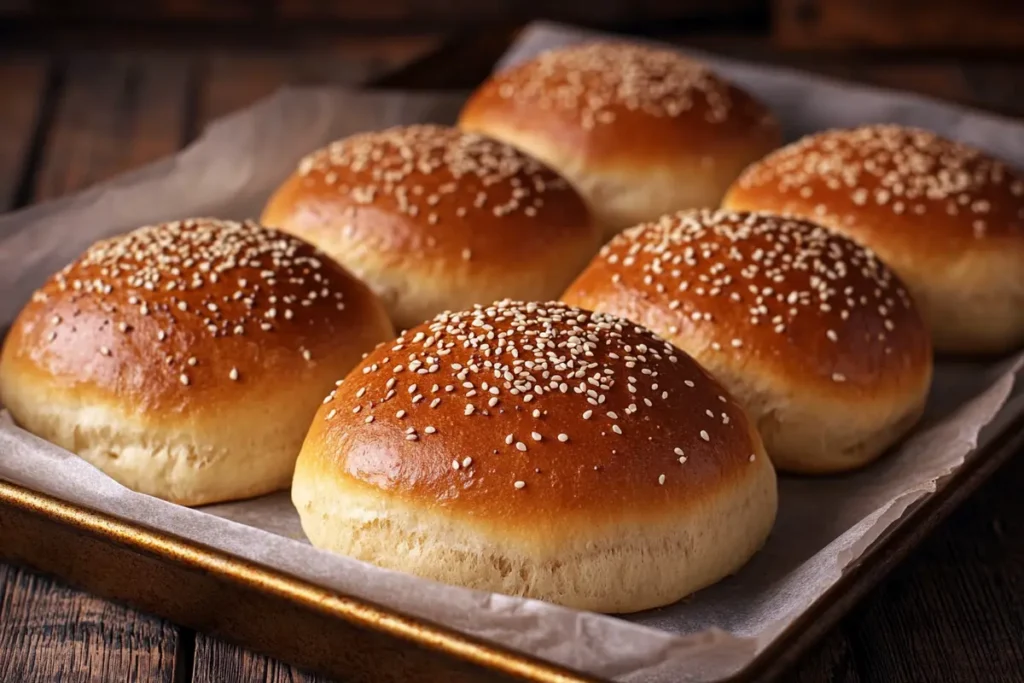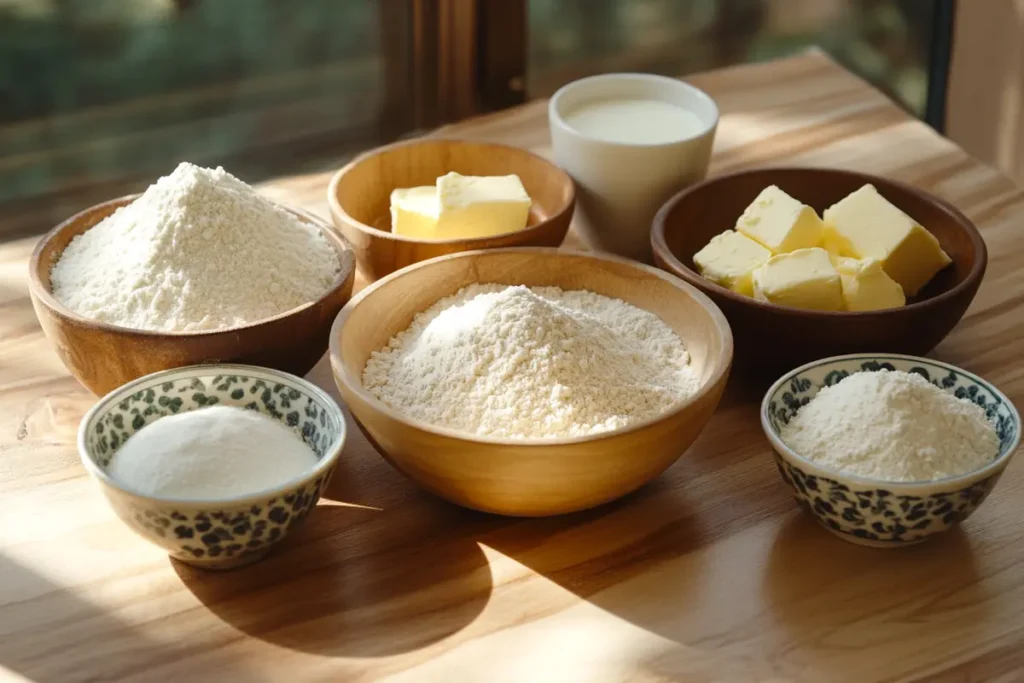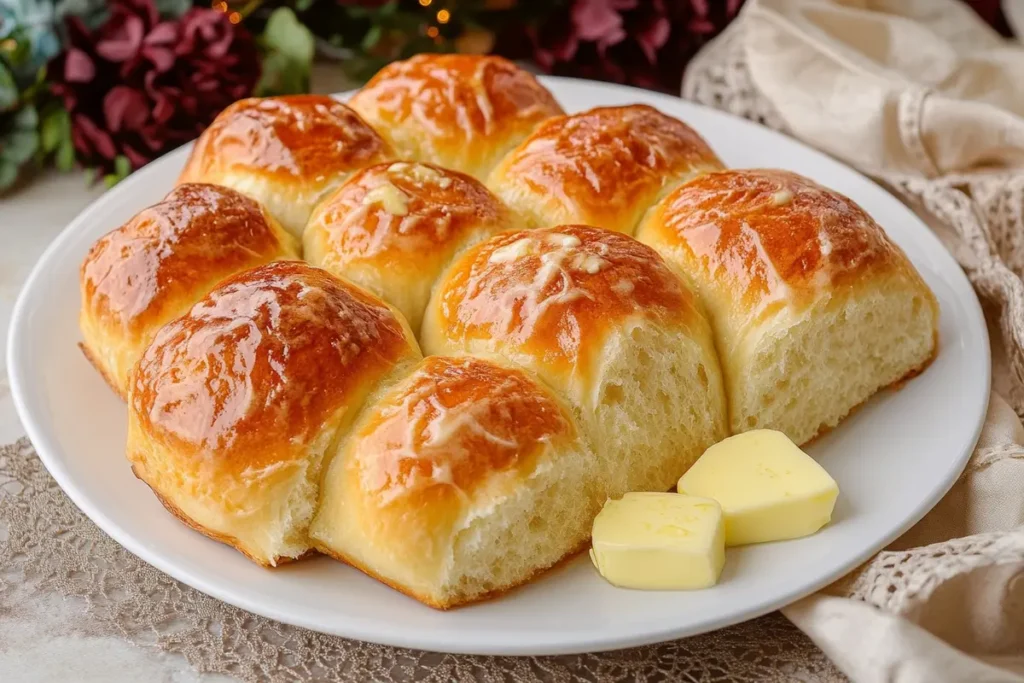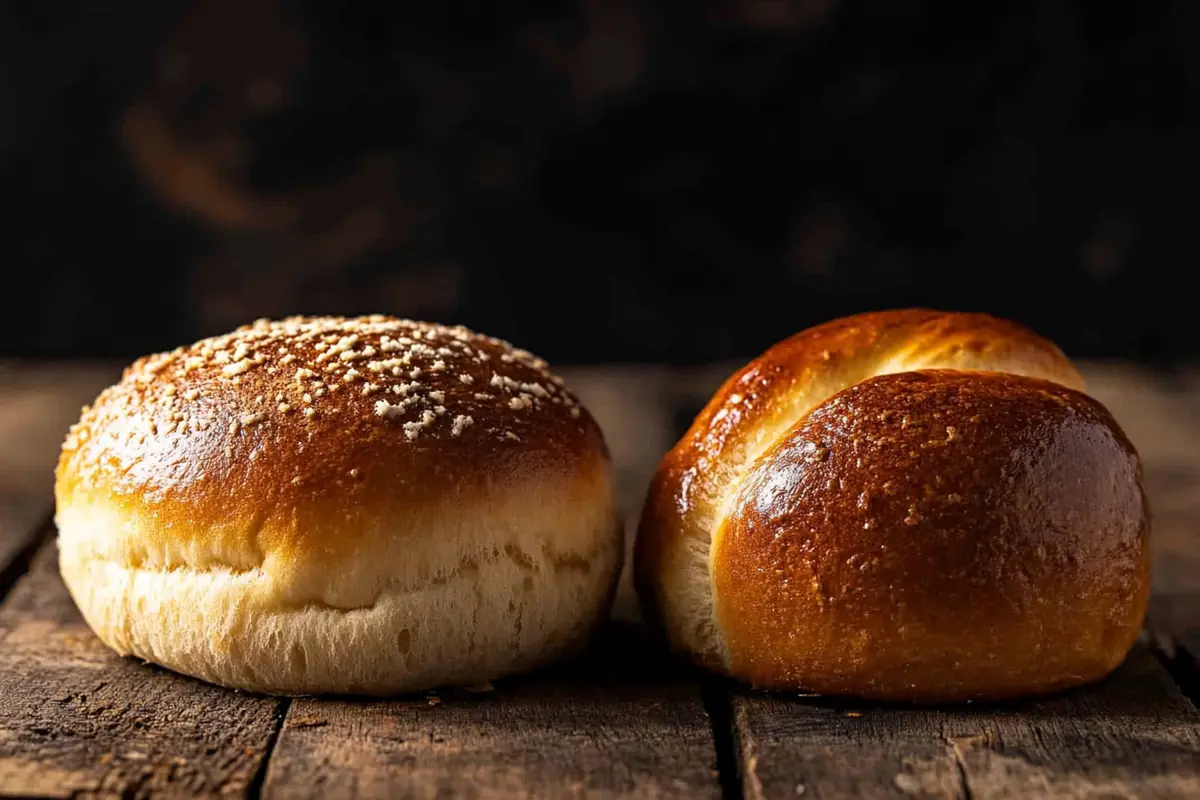Buns and dinner rolls are staples of cuisines worldwide, yet their differences are often misunderstood. This article dives into their characteristics, origins, ingredients, preparation methods, and culinary uses to provide clarity. By the end, you’ll not only know the key distinctions but also gain a deeper appreciation for these baked goods.
Table of Contents
Introduction
Understanding the difference between buns and dinner rolls goes beyond their appearances. These two baked delights hold unique roles in culinary traditions, yet they often overlap in ingredients and preparation. A bun, known for its utility in sandwiches and fast food, is distinct from a dinner roll, typically served as a side dish during meals.
This article takes you on a journey through their definitions, histories, and characteristics while answering common questions that even bakers and food enthusiasts might ponder. Whether you’re curious about their origins or need clarity on how they’re served, this guide has you covered.
Definition and Characteristics
What Is a Bun?
A bun is a type of bread that’s typically round, soft, and versatile. It’s often associated with handheld meals like burgers or hot dogs, but buns extend far beyond fast food. They can be sweet or savory, plain or topped with seeds, and used for everything from sandwiches to breakfast treats.
Most buns are slightly larger than dinner rolls, designed to hold fillings without falling apart. For instance, hamburger buns often feature a soft texture that can cradle patties, while brioche buns bring a buttery sweetness to gourmet sandwiches. The world of buns is as diverse as the dishes they’re used in.
What Is a Dinner Roll?
Unlike buns, dinner rolls are smaller, softer, and typically served as a side dish rather than the main feature. These golden, pillowy pieces of bread are often found on dining tables during holidays, family dinners, or formal events. Their primary role is to complement meals, soaking up gravies, butter, or other accompaniments.
Dinner rolls can be plain or creatively shaped, such as cloverleaf rolls or Parker House rolls. The dough for dinner rolls is often enriched with butter and milk, giving them a rich, tender crumb perfect for pairing with hearty dishes.
Key Differences in Characteristics
- Size and Shape: Buns are generally larger and flatter, while dinner rolls are smaller and rounder.
- Purpose: Buns are designed for utility holding fillings whereas dinner rolls are primarily enjoyed as a side dish.
- Texture: Dinner rolls are soft and fluffy, while buns may be firmer to support fillings like meat or vegetables.
- Toppings: Buns often feature toppings like sesame seeds, whereas dinner rolls are usually plain.
Each has its unique charm and purpose in the culinary world, making them irreplaceable in their respective roles.
Origins and Cultural Significance
The History of Buns
The origins of buns can be traced back to ancient bread-making traditions. As societies evolved, so did the art of creating compact, portable breads like buns. Historically, buns served as convenient, portion-sized bread for individuals, making them popular in street food and casual dining.
Cultures worldwide have embraced buns in their culinary heritage. For example, hamburger buns, a modern staple, emerged during the rise of fast food in the United States in the early 20th century. Sweet buns, such as brioche or cinnamon rolls, have long been enjoyed in European and Asian cuisines, showcasing the adaptability of buns in both savory and sweet dishes.
Interestingly, buns have often been at the center of festivities. For instance, celebratory buns like hot cross buns have roots in religious and seasonal traditions. Today, they continue to symbolize convenience and creativity in global cuisines.
The History of Dinner Rolls
Dinner rolls, on the other hand, boast origins steeped in formality and elegance. Emerging from European bread traditions, rolls were designed to accompany meals as a refined addition to dining tables. The Parker House roll, for instance, was invented in the 19th century at the Parker House Hotel in Boston, becoming a quintessential side for sophisticated dinners.
Dinner rolls gained prominence as a staple in holiday meals, particularly in North America, where they are often served during Thanksgiving and Christmas feasts. Their rich, buttery flavor and soft texture make them a comforting complement to hearty dishes like turkey, roasts, or soups.
These rolls have also evolved culturally, with variations like the Portuguese pãozinho or the Japanese milk roll, showcasing how different regions put their unique spin on this classic bread.
Cultural Significance of Buns and Dinner Rolls
While buns are associated with convenience and versatility, dinner rolls evoke a sense of tradition and togetherness. Buns have become symbols of casual dining and creativity, while dinner rolls carry an air of formality and indulgence.
For those interested in diving deeper into the history of bread-making, consider exploring The History of Bread to better understand how these baked goods fit into the broader story of bread.
Key Ingredients in Buns and Dinner Rolls
Core Ingredients in Buns
The ingredients for buns are simple yet versatile, giving them their unique texture and flavor. The foundational elements typically include:
- Flour: All-purpose or bread flour provides the structure.
- Yeast: Ensures the dough rises and gives buns their airy texture.
- Sugar: Often added for sweetness and to enhance browning.
- Salt: Balances flavors and strengthens the dough structure.
- Milk or Water: Adds moisture, with milk offering a richer crumb.
- Fat: Usually butter or oil, creating a soft and tender texture.
For certain types of buns, additional ingredients make them stand out. Brioche buns, for example, include eggs and extra butter for a rich, slightly sweet flavor. Similarly, sweet buns might incorporate honey, cinnamon, or dried fruits to create a dessert-like experience.

Core Ingredients in Dinner Rolls
Like buns, dinner rolls rely on a simple ingredient list but differ slightly in their preparation and purpose. Common ingredients include:
- Flour: Typically all-purpose flour for a soft texture.
- Yeast: A critical leavening agent to ensure fluffy rolls.
- Milk: Enriches the dough and enhances softness.
- Butter: Adds a rich, creamy flavor to the rolls.
- Sugar: Used in moderation to provide a slight sweetness.
- Salt: Balances and enhances the overall flavor.
Some variations of dinner rolls, like Parker House rolls, include more butter folded into the dough, creating a flaky, pull-apart texture. In contrast, Japanese milk bread rolls use tangzhong, a cooked flour-water mixture, for extra softness and longevity.
Ingredient Comparisons
While the ingredient lists for buns and dinner rolls may look similar, their proportions and applications differ significantly:
- Sweetness: Buns often lean sweeter or savory, while dinner rolls have a neutral, buttery profile.
- Fat Content: Dinner rolls generally include more butter for a softer crumb.
- Toppings: Buns may feature sesame seeds, poppy seeds, or glaze for flavor and decoration, while dinner rolls are typically served plain or brushed with butter.
This subtle divergence in ingredients results in the distinctive textures and flavors that set buns and dinner rolls apart.
For aspiring bakers, mastering the art of ingredient proportions is key to perfecting these breads. Check out Bread Baking Tips for expert advice on crafting the ideal dough for your next baking project.

Differences in Preparation and Baking Methods
How Buns Are Made
The process of making buns often revolves around creating a dough that is soft, yet sturdy enough to hold fillings. Here’s a typical method:
- Mixing and Kneading: Ingredients like flour, yeast, sugar, salt, and fat are combined and kneaded to form a smooth, elastic dough.
- First Proof: The dough is allowed to rise in a warm place until it doubles in size. This process develops the structure and enhances the flavor.
- Shaping: The dough is divided into portions, shaped into rounds or ovals, and sometimes flattened slightly, depending on the bun type.
- Second Proof: Once shaped, the buns undergo a second rise to ensure a soft and airy texture.
- Baking: Buns are baked at a slightly higher temperature to achieve a golden, glossy exterior.
Some buns, like bao buns, are steamed instead of baked, which results in a fluffy, moist texture. Others, such as brioche buns, may be brushed with egg wash for a shiny finish.
How Dinner Rolls Are Made
Dinner rolls involve similar steps but focus on achieving a tender, buttery crumb. The method often includes:
- Mixing and Enrichment: Dough for dinner rolls typically includes more milk and butter, creating a softer texture.
- First Proof: Like buns, the dough rises until it doubles in size.
- Shaping Techniques: Dinner rolls are often shaped into small, uniform balls or creative designs like knots or cloverleaf rolls.
- Second Proof: The rolls are allowed to rise again after shaping, ensuring they’re light and fluffy.
- Baking and Brushing: Dinner rolls are baked at a moderate temperature to maintain their soft texture, and many are brushed with melted butter immediately after baking for added richness.
Baking Time and Temperature Differences
Buns are usually baked at slightly higher temperatures (375–400°F) to ensure a firm crust, while dinner rolls are baked at lower temperatures (350–375°F) to keep their texture tender. The difference in temperature highlights their intended uses: buns need to hold fillings, while rolls should melt in your mouth.
Shaping Techniques for Buns and Rolls
- Buns: Shaped to be flat or slightly domed, often using molds for uniformity in commercial settings.
- Dinner Rolls: Crafted into various designs, from classic round shapes to braided knots or pull-apart clusters, adding visual appeal to the dinner table.
The method of preparation significantly influences the final product, making it essential to tailor the process to the type of bread you’re baking. Each step, from proofing to shaping, defines whether you end up with a resilient bun or a pillowy roll.
How Buns and Dinner Rolls Are Served
Common Uses for Buns
Buns are famously versatile, serving as the foundation for countless dishes. Their utility in meals stems from their sturdiness and ability to hold various fillings. Here are some of the most popular uses:
- Hamburger Buns: A quintessential pairing for burgers, buns are designed to cradle juicy patties, sauces, and toppings without falling apart.
- Sandwich Buns: Perfect for hearty sandwiches, buns like brioche or ciabatta add flavor and structure to fillings such as pulled pork, chicken, or veggies.
- Sweet Buns: Enriched buns, like cinnamon rolls or raisin-studded varieties, often double as desserts or breakfast treats.
- Specialty Buns: Bao buns and steamed varieties are common in Asian cuisines, often filled with savory or sweet ingredients.
The bun’s ability to adapt to different culinary styles makes it indispensable across global cuisines.
Common Uses for Dinner Rolls
Unlike buns, dinner rolls take a backseat as a side dish, enhancing the main course. Their softness and mild flavor make them ideal for complementing a variety of meals:
- Holiday Feasts: Dinner rolls are a staple on tables during Thanksgiving, Christmas, and Easter, providing a comforting, buttery addition to hearty dishes like roasted turkey, ham, or mashed potatoes.
- Daily Meals: Whether served alongside soups, stews, or pasta, dinner rolls add a touch of warmth and balance to everyday meals.
- Special Occasions: Rolls often feature in formal dinners and events, served warm with butter to elevate the dining experience.
Versatility in Serving
Though their primary roles differ, buns and rolls occasionally overlap. For example, sliders use mini buns to replicate the size and softness of dinner rolls. Additionally, both can be repurposed creatively, like turning stale rolls into breadcrumbs or buns into bread pudding.
The serving context often dictates whether a bun or a roll is more appropriate, but both bring their own charm and utility to the table.

FAQs About: Bun vs Dinner Roll
What makes a bun different from a roll?
The primary differences lie in their size, texture, and purpose. Buns are typically larger, slightly firmer, and designed to hold fillings like patties or vegetables. Dinner rolls, on the other hand, are smaller, softer, and meant to be served as a side dish, complementing the main meal.
Can a dinner roll be used as a bun?
Yes, but it depends on the dish. Dinner rolls can work as mini buns for sliders or smaller sandwiches. However, they may lack the structure needed for heavier fillings, as they are designed to be softer and more delicate.
Are buns sweeter than dinner rolls?
Not always. While some buns, like brioche or sweet rolls, are sweetened, many savory buns (e.g., hamburger buns) are not. Dinner rolls typically have a mildly sweet, buttery flavor but rarely lean heavily into sweetness.
What is the texture difference between buns and dinner rolls?
Buns are often denser and slightly chewy, making them sturdy enough for fillings. Dinner rolls, in contrast, are fluffier and more tender due to their higher fat content, making them melt in your mouth.
Conclusion
Wrapping Up the Difference Between a Bun and a Dinner Roll
Understanding the difference between a bun and a dinner roll is essential for appreciating their unique roles in culinary traditions. While buns are versatile and often the centerpiece of a dish, dinner rolls complement meals with their soft, buttery charm.
Buns shine as sandwich bases, burger holders, or sweet treats, designed to be functional and flavorful. Dinner rolls, on the other hand, are smaller, softer, and reserved for enhancing meals, especially during holidays and special occasions. From their ingredients and preparation methods to how they’re served, buns and rolls bring distinct experiences to the table.
By exploring their characteristics, cultural roots, and uses, we can see that buns and dinner rolls, though similar in some ways, hold unique places in the world of bread. The next time you reach for one, you’ll know exactly what makes it special—and perhaps even choose the perfect bread for your meal!

